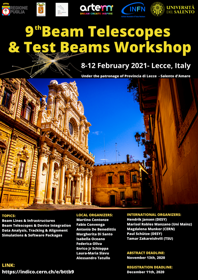Speakers
Description
Contribution will be presented in two parts:
I.
In 2027 CERN is expected to start the High-Luminosity LHC (HL-LHC) phase. HL-LHC will integrate 10 times the current luminosity, leading to a high pile-up rate and unprecendent radiation levels. In order to cope with such a harsh environment and maintain the current physics performance, a major upgrade of the LHC detectors is required. As part of the HL-LHC detector upgrade programme, the CMS experiment is developing a High Granularity Calorimeter (HGCAL) to replace the existing endcap calorimeters. The HGCAL will be realised as a sampling calorimeter, including 36 layers of silicon pads and 14 layers combining both silicon and scintillator detectors interspersed with metal absorber plates. Prototype modules based on 6-inch hexagonal silicon pad sensors with pad areas of 1.0~cm$ ^2 $ have been constructed. Beam tests of different sampling configurations made from these modules have been conducted at the CERN SPS using beams of charged hadrons and positrons with momenta ranging from 20 to 300~GeV/c. Beam tests play a key role in the validation of the detector's design as well as in the study of the expected physics performance. In October 2018 the first large scale prototype of HGCAL, consisting of O(100) modules, was tested.
After a general overview of the CMS upgrade campaign for the HL-LHC, a more detailed description of the HGCAL and the experimental set up used in the test beam, the contribution describes the assessment of the electromagnetic compartment's performance. Besides the standard quantities of calorimetry, such as energy resolution and linearity, the high granularity of the prototype is exploited to characterize longitudinal and transversal profiles, by measuring the average shower depth and the Moliere Radius. Measurements of the position and angular resolution are also presented. Data are compared with a dedicated GEANT4 Monte Carlo simulation and an excellent agreement is found for all the observables studied.
II.
The existing CMS endcap calorimeters will be replaced with a High Granularity Calorimeter (HGCAL) for operation at the High Luminosity (HL) LHC. Radiation hardness and excellent physics performance will be achieved by utilising silicon pad sensors and SiPM-on-scintillator tiles with high transverse and longitudinal segmentation. One of the major challenges of the HL-LHC will be the high pileup environment, with interaction vertices spread not only in position, but also in time. In order to efficiently reject particles originating from pileup, precision timing information of the order of 30 ps will be of great benefit. In order to meet such performance goals, the HGCAL will provide timing measurements for individual hits with signals above 12 fC (equivalent to 3-10 MIPs), such that clusters resulting from particles with pT > 5 GeV should have a timing resolution better than 30ps.
In order to assess the technical feasibility and physics performance of such a design, beam tests were performed with a prototype of HGCAL silicon modules at the CERN SPS in 2018. We present the detector and DAQ components related to the precision timing evaluation, as well as calibration techniques and preliminary results on the timing performance of the prototype.
